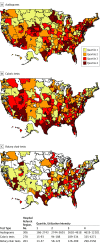Clinician Use and Payments by Medical Specialty for Audiometric and Vestibular Testing Among US Medicare Beneficiaries
- PMID: 31855260
- PMCID: PMC6990930
- DOI: 10.1001/jamaoto.2019.3924
Clinician Use and Payments by Medical Specialty for Audiometric and Vestibular Testing Among US Medicare Beneficiaries
Abstract
Importance: Variations in diagnostic test use may indicate that there are opportunities for quality improvement in vestibular health care. To date, the extent to which clinician acquisition of tests varies nationwide by region and specialty of the clinician is unknown.
Objective: To quantify variation in clinician use and payments for audiograms and vestibular tests across all geographic regions of the United States and by specialty of practice.
Design, setting, and participants: This cross-sectional study used a population-based sample of 1 307 887 audiovestibular test claims from fee-for-service Medicare beneficiaries aged 65 years or older in the Medicare Provider Utilization and Payment Public Use File from January 1 through December 31, 2014. The analysis was completed from January 2 through June 1, 2019.
Exposures: Diagnostic audiograms, caloric testing, and rotary chair testing.
Main outcomes and measures: Test utilization was analyzed by hospital referral region, medical specialty, and total payments.
Results: In 2014, clinicians performed 1 213 328 audiograms, 317 880 caloric tests (ie, single caloric irrigations), and 62 779 rotary chair tests, for a total of $38 647 350.21 in Medicare payments from the Centers for Medicare & Medicaid Services. No patient or clinician demographic characteristics were available. Across health care referral regions, rates of testing per 100 000 beneficiaries varied from 166 to 12 021 for audiograms, 15 to 4271 for caloric tests, and 13 to 3556 for rotary chair tests between the lowest-use and highest-use regions. Most audiograms and caloric tests were billed by audiologists (797 957 audiograms [65.8%]; 112 485 caloric tests [35.4%]) and otolaryngologists (376 728 audiograms [31.0%]; 70 567 caloric tests [22.2%]). In contrast, primary care physicians (18 933 [30.2%]) and neurologists (15 254 [24.3%]) billed the largest proportion of rotary chair tests compared with other specialists, including audiologists (7253 [11.6%]) and otolaryngologists (6464 [10.3%]).
Conclusions and relevance: Substantial geographic and clinician-level variation may have been observed in use of audiovestibular tests. Quality improvement efforts in vestibular health care may need to target a range of clinicians, including primary care physicians to be successful.
Conflict of interest statement
Figures

Comment in
- doi: 10.1001/jamaoto.2019.3950
Similar articles
-
Geographic Variation in the Use of Audiovestibular Testing-Too Much or Too Little?JAMA Otolaryngol Head Neck Surg. 2020 Feb 1;146(2):150-151. doi: 10.1001/jamaoto.2019.3950. JAMA Otolaryngol Head Neck Surg. 2020. PMID: 31855242 No abstract available.
-
Geographic Variation in Use of Vestibular Testing among Medicare Beneficiaries.Otolaryngol Head Neck Surg. 2017 Feb;156(2):312-320. doi: 10.1177/0194599816676450. Epub 2016 Nov 14. Otolaryngol Head Neck Surg. 2017. PMID: 28145840
-
Association of the Comprehensive End-Stage Renal Disease Care Model With Medicare Payments and Quality of Care for Beneficiaries With End-Stage Renal Disease.JAMA Intern Med. 2020 Jun 1;180(6):852-860. doi: 10.1001/jamainternmed.2020.0562. JAMA Intern Med. 2020. PMID: 32227133 Free PMC article.
-
Variations in payment patterns for surgical care in the centers for Medicare and Medicaid Services.Surgery. 2017 Feb;161(2):312-319. doi: 10.1016/j.surg.2015.12.028. Epub 2016 Feb 26. Surgery. 2017. PMID: 26922367 Review.
-
Medicare in the 21 st Century: Understanding the Program to Promote Improvements.J Am Acad Orthop Surg. 2024 May 15;32(10):427-438. doi: 10.5435/JAAOS-D-23-00464. Epub 2024 Apr 9. J Am Acad Orthop Surg. 2024. PMID: 38595137 Free PMC article. Review.
Cited by
-
Comparative utility of vestibular function tests in patients with peripheral and central vestibular dysfunction.J Otol. 2024 Jan;19(1):5-9. doi: 10.1016/j.joto.2023.10.002. Epub 2023 Nov 3. J Otol. 2024. PMID: 38313756 Free PMC article.
-
Dizziness Diagnostic Pathways: Factors Impacting Setting, Provider, and Diagnosis at Presentation.Otolaryngol Head Neck Surg. 2022 Jan;166(1):158-166. doi: 10.1177/01945998211004245. Epub 2021 Apr 13. Otolaryngol Head Neck Surg. 2022. PMID: 33845655 Free PMC article.
-
Nationwide Utilization of Computerized Dynamic Posturography in an Era of Deimplementation.Otolaryngol Head Neck Surg. 2023 Oct;169(4):1090-1093. doi: 10.1002/ohn.333. Epub 2023 Mar 30. Otolaryngol Head Neck Surg. 2023. PMID: 36994931 Free PMC article.
-
Gender-differences of proceduralists in perception of hand-held surgical instrument fit - A cross-sectional survey.Am J Surg. 2022 Dec;224(6):1482-1487. doi: 10.1016/j.amjsurg.2022.05.011. Epub 2022 May 15. Am J Surg. 2022. PMID: 35606179 Free PMC article.
-
Efficient Use of Vestibular Testing.Otolaryngol Clin North Am. 2021 Oct;54(5):875-891. doi: 10.1016/j.otc.2021.05.011. Epub 2021 Jul 20. Otolaryngol Clin North Am. 2021. PMID: 34294436 Free PMC article. Review.
References
-
- Bisdorff A, Von Brevern M, Lempert T, Newman-Toker DE. Classification of vestibular symptoms: towards an international classification of vestibular disorders. J Vestib Res. 2009;19(1-2):1-13. - PubMed
-
- Sloane PD. Dizziness in primary care: results from the National Ambulatory Medical Care Survey. J Fam Pract. 1989;29(1):33-38. - PubMed
Publication types
MeSH terms
Grants and funding
LinkOut - more resources
Full Text Sources
Medical

